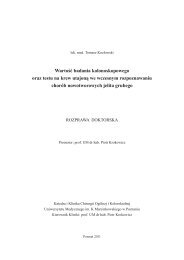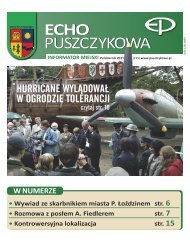MILITARY PHARMACY AND MEDICINE
MILITARY PHARMACY AND MEDICINE
MILITARY PHARMACY AND MEDICINE
Create successful ePaper yourself
Turn your PDF publications into a flip-book with our unique Google optimized e-Paper software.
© Military Pharmacy and Medicine • 2012 • 4 • 105 – 110Łukasz Szarpak: Selected aspects of communication between emergency services …Emergency medicineSelected aspects of communication between emergency servicesand the mass media in crisis situationsŁukasz Szarpak, Marcin MadziałaCollegium Masoviense – College of Health Sciences in Żyrardów, PolandAuthor’s address:Łukasz Szarpak, Collegium Masoviense – College of Health Science, ul. G. Narutowicza 35, 96-300 Żyrardów,Poland; phone: (+48) 500 186 225, e–mail: lukasz.szarpak@gmail.comReceived: 2012.07.18 • Accepted: 2012.09.11 • Published: 2012.09.28Summary:We live in times where information is the supreme value. The mass media seek sensation and oftenmisinterpret the situation, which usually occurs in the case of limited access to information. Due totheir mediagenic nature, crisis situations as well as emergency actions taken to eliminate their consequencesare undoubtedly a treat for journalists. Correctly performed rescue operations are essentialduring events that make people suffer or feel endangered. Nonetheless, appropriate conveying informationabout performed actions to the media, and then to the society, is a crucial element of rescue operationsand influences both perception of emergency services and prevention from spreading speculationand panic in the society.Key words: media, crisis situation, rescue operation, emergency services, panic.IntroductionContinuous civilization development and growingpopulation make us live in expandingagglomerations, which results in the fact thatthe issue of disasters is becoming increasinglyimportant. Phenomena bearing marks of crisis,although varied and reaching different extents,which makes it difficult to define them precisely,have some common features [1-3]. Firstly, in viewof the fact that nobody can expect crisis situationsat a particular time and in a particular place, theaffected population is usually helpless. Secondly,the extent of damage and number of people inneed exceed the ability to satisfy all expectations.Another feature of crisis situations is their mediagenicnature [2,3].For hundreds of years, since humans startedto deal with disastrous events, the concept ofhttp://military.isl-journals.comcatastrophe has evolved. At present, there arenumerous definitions of “catastrophe”[4]. Themost accurate one, with regard to the way ofthinking in any situation that surpasses in extentthe abilities of rescuers and bears the features ofcatastrophe, is a definition approved in the USAby the Federal Emergency Management Agency(FEMA) [5]. It defines catastrophe as an eventcausing death, injuries or damage to possessions,to an extent that makes routine emergencyactions insufficient. According to this definition,catastrophe occurs suddenly and requires immediate,coordinated actions taken by many individualsand institutions.Efficient crisis management is not only a medicalemergency assistance provided to casualties.One of the basic conditions of effective105
















